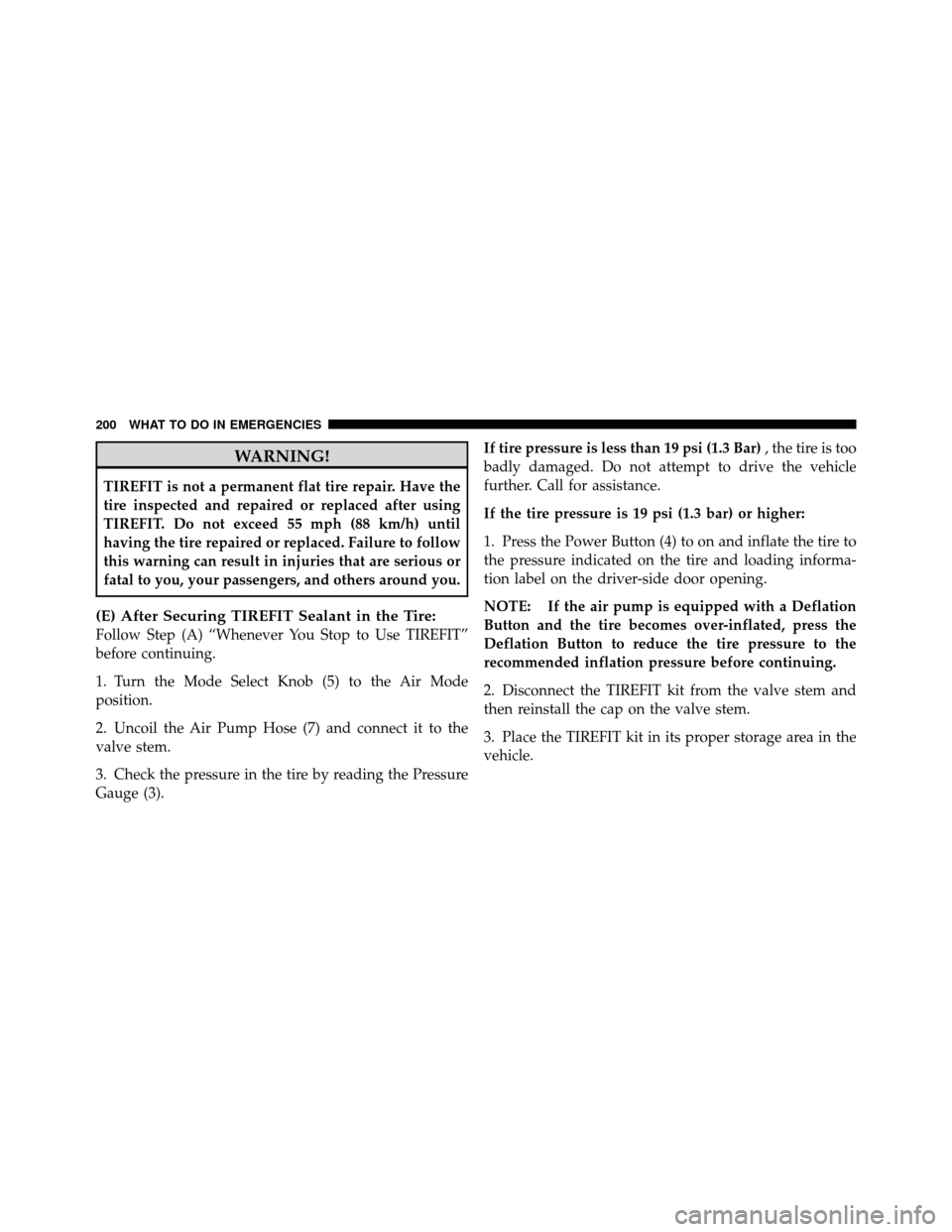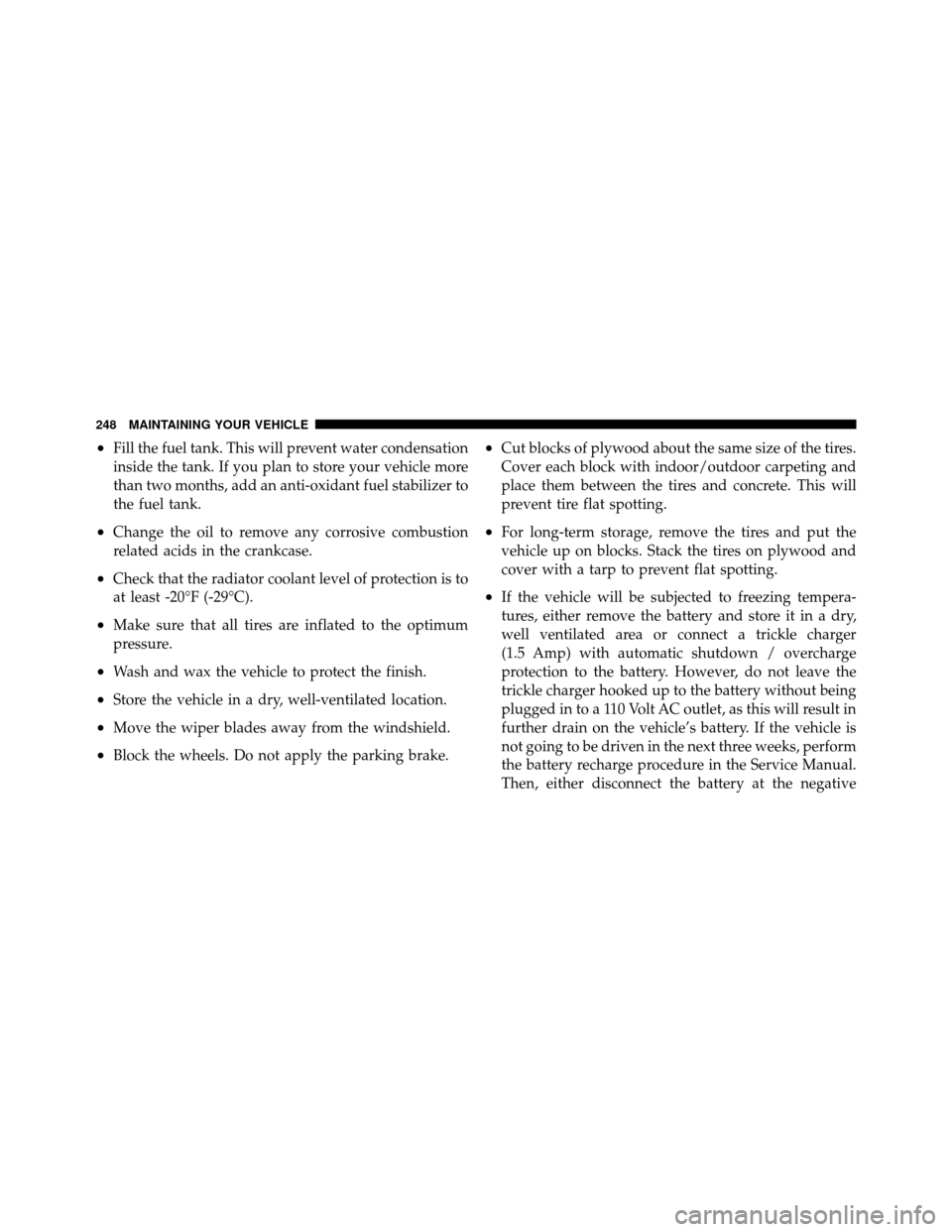Page 204 of 315

WARNING!
TIREFIT is not a permanent flat tire repair. Have the
tire inspected and repaired or replaced after using
TIREFIT. Do not exceed 55 mph (88 km/h) until
having the tire repaired or replaced. Failure to follow
this warning can result in injuries that are serious or
fatal to you, your passengers, and others around you.
(E) After Securing TIREFIT Sealant in the Tire:
Follow Step (A) “Whenever You Stop to Use TIREFIT”
before continuing.
1. Turn the Mode Select Knob (5) to the Air Mode
position.
2. Uncoil the Air Pump Hose (7) and connect it to the
valve stem.
3. Check the pressure in the tire by reading the Pressure
Gauge (3).If tire pressure is less than 19 psi (1.3 Bar)
, the tire is too
badly damaged. Do not attempt to drive the vehicle
further. Call for assistance.
If the tire pressure is 19 psi (1.3 bar) or higher:
1. Press the Power Button (4) to on and inflate the tire to
the pressure indicated on the tire and loading informa-
tion label on the driver-side door opening.
NOTE: If the air pump is equipped with a Deflation
Button and the tire becomes over-inflated, press the
Deflation Button to reduce the tire pressure to the
recommended inflation pressure before continuing.
2. Disconnect the TIREFIT kit from the valve stem and
then reinstall the cap on the valve stem.
3. Place the TIREFIT kit in its proper storage area in the
vehicle.
200 WHAT TO DO IN EMERGENCIES
Page 210 of 315
CAUTION! (Continued)
•Revving the engine or spinning the wheels too fast
may lead to transmission overheating and failure.
It can also damage the tires. Do not spin the
wheels above 30 mph (48 km/h) while in gear (no
transmission shifting occurring).
WARNING!
Fast spinning tires can be dangerous. Forces gener-
ated by excessive wheel speeds may cause damage, or
even failure, of the axle and tires. A tire could
explode and injure someone. Do not spin your vehi-
cle’s wheels faster than 30 mph (48 km/h) or for
longer than 30 seconds continuously without stop-
ping when you are stuck. And do not let anyone near
a spinning wheel, no matter what the speed.
TOWING A DISABLED VEHICLE
Do not tow with sling-type equipment. Only use flatbed
equipment. Always comply with applicable state or local
towing ordinances.
CAUTION!
Towing with equipment other than flatbed types may
damage your vehicle.
206 WHAT TO DO IN EMERGENCIES
Page 252 of 315

•Fill the fuel tank. This will prevent water condensation
inside the tank. If you plan to store your vehicle more
than two months, add an anti-oxidant fuel stabilizer to
the fuel tank.
•Change the oil to remove any corrosive combustion
related acids in the crankcase.
•Check that the radiator coolant level of protection is to
at least -20°F (-29°C).
•Make sure that all tires are inflated to the optimum
pressure.
•Wash and wax the vehicle to protect the finish.
•Store the vehicle in a dry, well-ventilated location.
•Move the wiper blades away from the windshield.
•Block the wheels. Do not apply the parking brake.
•Cut blocks of plywood about the same size of the tires.
Cover each block with indoor/outdoor carpeting and
place them between the tires and concrete. This will
prevent tire flat spotting.
•For long-term storage, remove the tires and put the
vehicle up on blocks. Stack the tires on plywood and
cover with a tarp to prevent flat spotting.
•If the vehicle will be subjected to freezing tempera-
tures, either remove the battery and store it in a dry,
well ventilated area or connect a trickle charger
(1.5 Amp) with automatic shutdown / overcharge
protection to the battery. However, do not leave the
trickle charger hooked up to the battery without being
plugged in to a 110 Volt AC outlet, as this will result in
further drain on the vehicle’s battery. If the vehicle is
not going to be driven in the next three weeks, perform
the battery recharge procedure in the Service Manual.
Then, either disconnect the battery at the negative
248 MAINTAINING YOUR VEHICLE
Page 298 of 315
Temperature Grades
The temperature grades are A (the highest), B, and C,
representing the tire’s resistance to the generation of heat
and its ability to dissipate heat, when tested under
controlled conditions on a specified indoor laboratory
test wheel. Sustained high temperature can cause the
material of the tire to degenerate and reduce tire life, and
excessive temperature can lead to sudden tire failure. The
grade C corresponds to a level of performance, which all
passenger car tires must meet under the Federal Motor
Vehicle Safety Standard No. 109. Grades B and A repre-
sent higher levels of performance on the laboratory test
wheel, than the minimum required by law.WARNING!
The temperature grade for this tire is established for
a tire that is properly inflated and not overloaded.
Excessive speed, under-inflation, or excessive load-
ing, either separately or in combination, can cause
heat buildup and possible tire failure.
294 IF YOU NEED CONSUMER ASSISTANCE
Page 306 of 315

Time Delay........................... 89
Heater ............................... 134
High Beam Indicator ..................... 109
High Beam/Low Beam Select (Dimmer) Switch . . . 91
Hood Release ........................... 86
Hydraulic Clutch Fluid .................... 236
Ignition ............................... 12
Key ................................ 12
Ignition Key Removal ..................... 12
Illuminated Entry ........................ 17
Infant Restraint ........................ 56,57
Inflation Pressure Tires .................... 113
Inside Rearview Mirror .................... 82
Instrument Panel and Controls .............. 107
Instrument Panel Lens Cleaning ............. 240
Interior Appearance Care .................. 239
Interior Lighting ....................... 88,91
Interior Lights ......................... 91,93Intermittent Wipers (Delay Wipers)
............ 95
Introduction ............................. 4
Jump Starting .......................... 202
Key-In Reminder ......................... 13
Keyless Entry System ...................... 18
Keys ................................. 12
Knee Bolster ............................ 42
Lane Change and Turn Signals ............... 91
Lap/Shoulder Belts ....................... 34
Latch Plate ............................. 35
Latches ................................ 67
Hood ............................... 86
Lead Free Gasoline ...................... 181
Leaks, Fluid ............................ 67
Life of Tires ............................ 176
Liftgate ................................ 29
302 INDEX
Page 312 of 315

Shoulder Belts........................... 34
Signals, Turn ....................... 67,91,111
Slippery Surfaces, Driving On ............... 151
Snow Tires ............................ 178
Speedometer ........................... 108
Starting ............................... 144
Emergency (Jump Starting) ............... 202
Engine Fails to Start .................... 146
Starting and Operating .................... 144
Starting Procedures ...................... 144
Steering Power .............................. 154
Tilt Column ........................... 96
Storage ............................... 247
Storage, Vehicle ......................... 138
Stuck, Freeing .......................... 205
Supplemental Restraint System - Airbag ........ 42
Synthetic Engine Oil ...................... 215 Tachometer
............................ 116
Temperature Gauge, Engine Coolant .......... 116
Theft Alarm (Security Alarm) ................ 13
Theft System (Security Alarm) ............... 13
Tilt Steering Column ...................... 96
Tire and Loading Information Placard ......... 167
Tire Identification Number (TIN) ............. 165
Tire Markings .......................... 161
Tire Safety Information .................... 161
TIREFIT .............................. 191
Tires ............................ 67,171,293
Aging (Life of Tires) .................... 176
Air Pressure .......................... 171
General Information .................... 171
High Speed .......................... 174
Inflation Pressures ..................... 172
Life of Tires .......................... 176
Load Capacity ..................... 167,168
Pressure Monitor System (TPMS) ........... 179
308 INDEX